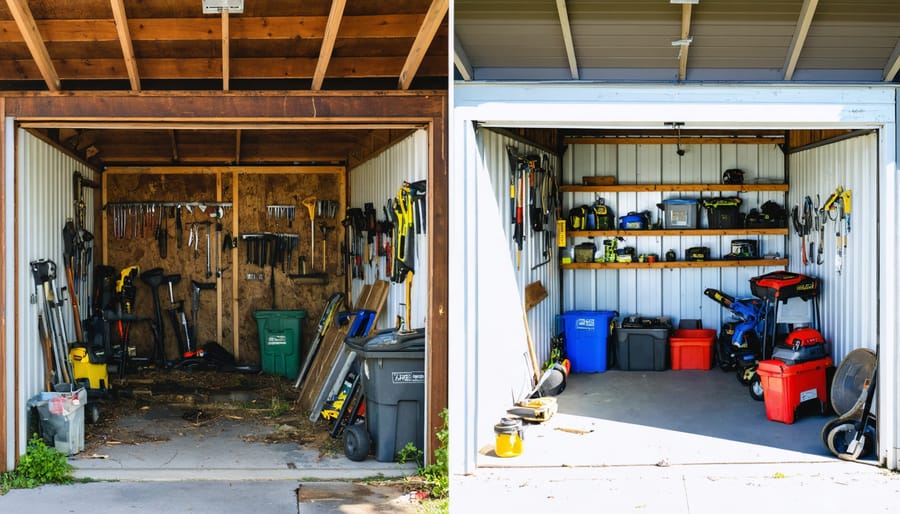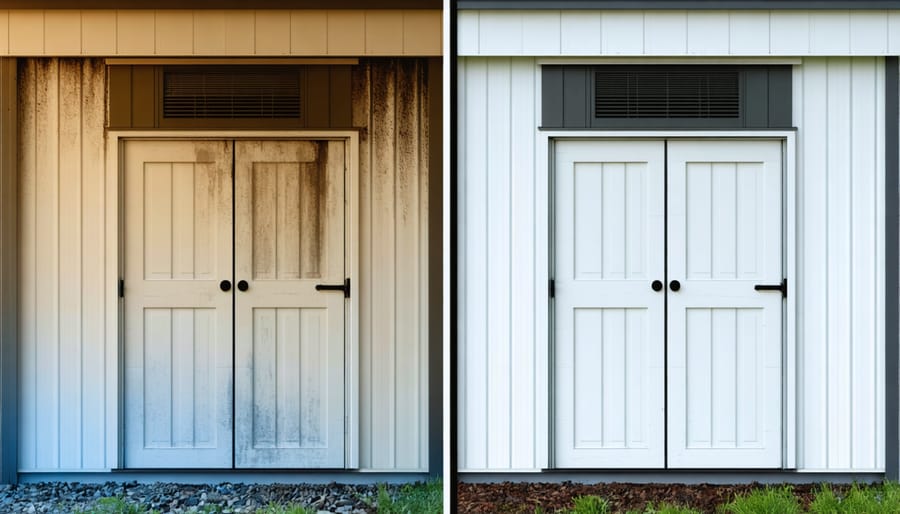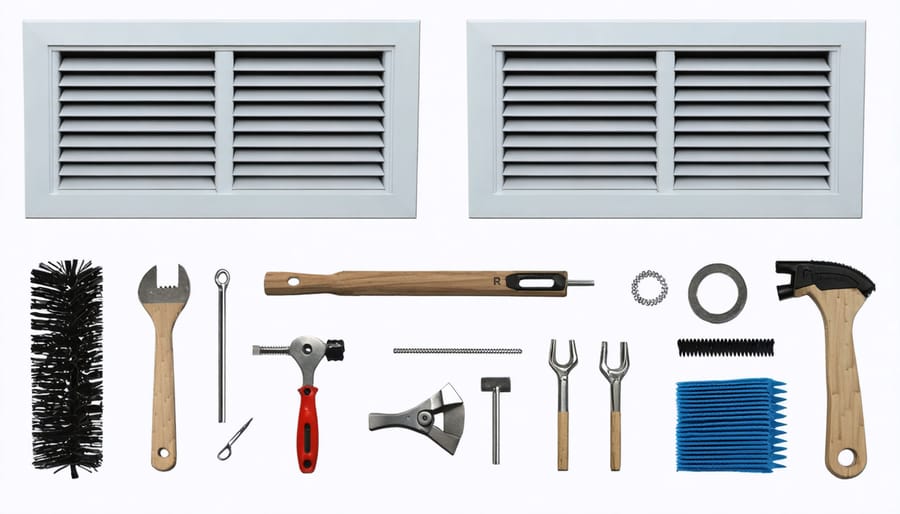Smart Ventilation Makes Your Storage Shed Last Longer (Here’s How)

Protect your valuable outdoor equipment and seasonal items with a properly ventilated storage shed – the cornerstone of effective long-term storage and item preservation. Modern ventilated sheds combine strategic airflow design with durable construction, preventing moisture buildup, mold growth, and rust while maintaining optimal storage conditions year-round. Whether you’re storing power tools, holiday decorations, or garden equipment, proper ventilation transforms a basic storage space into a climate-controlled environment that extends the life of your belongings. From passive roof vents to solar-powered exhaust systems, today’s ventilated storage solutions offer homeowners practical, cost-effective options that blend seamlessly with any property’s aesthetic while delivering superior protection against humidity, temperature fluctuations, and seasonal weather challenges.
Why Your Storage Shed Needs to Breathe
Moisture: Your Stored Items’ Silent Enemy
Moisture is one of the biggest threats to your stored belongings, silently causing damage that often goes unnoticed until it’s too late. High humidity levels can lead to mold growth, wood warping, fabric deterioration, and metal corrosion. Without proper ventilation, even sealed plastic containers can trap moisture, creating a perfect environment for mildew. To prevent tools from rusting and keep other valuable items safe, controlling humidity is essential. Common signs of moisture problems include musty odors, condensation on windows or walls, and dampness in stored fabrics. Items particularly vulnerable to moisture damage include power tools, garden equipment, books, photographs, and seasonal decorations. By understanding these risks, you can take proactive steps to protect your investments through proper ventilation solutions.

Temperature Control Through Air Movement
Proper air movement in your storage shed plays a crucial role in maintaining ideal temperatures throughout the year. During hot summer months, ventilation helps expel warm air that accumulates near the roof, preventing your shed from becoming a sweltering hotbox that could damage temperature-sensitive items. The natural airflow creates a cooling effect, much like a gentle breeze through your home’s windows.
In winter, consistent air circulation helps prevent moisture buildup and reduces temperature fluctuations that can lead to condensation. This is particularly important for protecting metal tools from rust and keeping stored fabrics free from mildew. The key is to create a balanced airflow pattern – cool air enters through lower vents while warm air exits through upper ones, establishing a natural convection cycle.
By maintaining this continuous air exchange, your shed stays cooler in summer and drier in winter, providing optimal storage conditions year-round.

Smart Ventilation Features for Every Season
Summer Ventilation Solutions
When summer temperatures soar, effective climate control for storage sheds becomes crucial. Start by installing adjustable roof vents that allow hot air to escape naturally. These work best when paired with low-wall vents, creating a continuous airflow that keeps your stored items cool and dry.
Consider adding a solar-powered ventilation fan to boost air circulation on particularly hot days. These energy-efficient units can be mounted on the roof or gable ends and operate automatically when temperatures rise. For additional cooling, install reflective foil insulation under your roof panels to deflect heat before it builds up inside.
Window placement matters too. If possible, position small windows on opposite walls to create cross-ventilation. Add adjustable screens to keep insects out while letting breeze flow through. For those hot, still days, a battery-operated fan placed strategically near entrance points can make a significant difference.
Don’t forget about door ventilation – installing a screen door or adding ventilation panels to your existing door provides extra airflow while maintaining security. These simple yet effective solutions help maintain ideal storage conditions throughout the summer months.
Winter Air Management
Winter storage requires special attention to ventilation to prevent moisture buildup while keeping your items protected from harsh elements. During colder months, reduce but don’t completely close off airflow to maintain a healthy balance. Install adjustable vents that can be partially covered during extreme weather, or use removable vent covers to control airflow.
Consider adding a small solar-powered fan that runs during daylight hours to keep air moving, even on chilly days. This helps prevent stagnant air pockets where condensation can form. Place moisture-absorbing products, like silica gel packets or dehumidifying crystals, near sensitive items for extra protection.
On milder winter days, open your shed doors for 15-20 minutes to allow fresh air circulation. Monitor internal temperature and humidity levels with an inexpensive thermometer-hygrometer combo device. Aim to maintain relative humidity below 60% to prevent mold growth and rust formation.
Remember to check stored items regularly and adjust ventilation as needed based on weather conditions. Items stored near the floor should be elevated on pallets or shelves to promote better air circulation during winter months.
Spring and Fall Transitions
As temperatures shift between seasons, your ventilated storage shed requires adjustments to maintain optimal conditions. During spring, gradually increase ventilation by opening additional vents and checking that all airways are clear of winter debris. This helps manage moisture from spring rains while preventing condensation as temperatures rise. When fall approaches, begin reducing airflow while maintaining enough ventilation to prevent stagnant air. These seasonal transitions are crucial for creating effective year-round storage solutions. Consider installing adjustable vents or louvered windows that can be easily modified as needed. Remember to check weather stripping and seals during these transition periods, ensuring they’re intact for the coming season. A well-planned ventilation strategy during these changing seasons will protect your stored items and extend your shed’s lifespan.
Installing and Upgrading Ventilation Systems
DIY Ventilation Solutions
Improving your shed’s ventilation doesn’t always require a complete rebuild. Several simple DIY modifications can significantly enhance airflow and protect your stored items. Start by installing adjustable vents near the roof line – these affordable units can be easily mounted using basic tools and provide controlled airflow management.
Creating custom soffit vents is another effective solution. Cut small openings under the eaves and cover them with mesh screening to prevent pest entry while allowing air movement. For gable-end sheds, consider adding a solar-powered vent fan, which operates automatically during daylight hours without requiring electrical connections.
Door and window modifications can make a big difference too. Install door sweeps with built-in ventilation gaps, or add louvered panels to solid doors. If your shed has windows, consider replacing fixed panes with adjustable versions that can be opened for cross-ventilation.
For floor-level ventilation, drill a series of small holes along the base of the walls and cover them with decorative vent covers. This creates a natural chimney effect as warm air rises and exits through upper vents. You can also install foundation vents if your shed sits on a raised platform.
Remember to position these ventilation solutions strategically, considering prevailing winds and sun exposure. Start with one or two modifications and monitor the results before adding more. This approach helps you achieve optimal airflow without overdoing it.

Professional Ventilation Options
For those seeking professional-grade ventilation solutions, several effective options can significantly enhance your storage shed’s air circulation. Powered ventilation systems, such as solar-powered vents and electric exhaust fans, offer consistent airflow regardless of weather conditions. These systems typically mount on the roof or gable ends and can be particularly beneficial for larger sheds or those storing sensitive equipment.
Ridge vents, installed along the peak of your shed’s roof, work in tandem with soffit vents to create a natural chimney effect. This combination is especially effective in hot climates, as it allows warm air to escape through the top while drawing cooler air in from below. Many homeowners find this passive system ideal because it requires no electricity and operates silently.
Turbine ventilators, also known as whirlybirds, are another excellent option. These wind-driven devices create continuous air movement without any power source. When properly installed, they can extract hot, humid air from your shed while being virtually maintenance-free.
Before installing any professional ventilation system, consider factors such as:
– Your local climate conditions
– The size and location of your shed
– The types of items you’ll be storing
– Local building codes and restrictions
– Installation costs and ongoing maintenance requirements
For optimal results, consult with a professional contractor who can assess your specific needs and recommend the most suitable ventilation solution for your storage shed.
Maintenance Tips for Ventilated Storage
Regular maintenance of your ventilated storage shed ensures it continues to protect your belongings effectively. Start with a monthly visual inspection of all vents, checking for any debris, cobwebs, or blockages that might restrict airflow. Use a soft brush or vacuum to clear these obstructions gently.
Inspect weather stripping around doors and windows each season, replacing any damaged pieces to maintain proper air circulation. During spring and fall, clean your vents thoroughly with a damp cloth and mild soap solution, ensuring they’re completely dry before closing.
Check your foundation vents quarterly, ensuring they remain unobstructed by growing vegetation or accumulated soil. If your shed has mechanical ventilation, such as fans or powered vents, test them monthly and clean the blades to prevent dust buildup that could affect performance.
Keep gutters clear if your shed has them, as proper water drainage helps prevent moisture-related ventilation issues. During humid seasons, consider using a humidity meter to monitor moisture levels inside your shed. If readings consistently show high humidity, you might need to adjust your ventilation setup or add a dehumidifier.
Don’t forget to lubricate moving parts of adjustable vents annually with silicone spray to ensure smooth operation. Finally, conduct a thorough inspection after severe weather events to check for any damage that might compromise your shed’s ventilation system.
A well-ventilated storage shed is more than just a place to keep your belongings – it’s an investment in protecting your valuable items while maintaining an organized outdoor space. By incorporating proper ventilation through roof vents, wall louvers, or ridge vents, you’ll create an environment that fights moisture, prevents mold, and extends the life of both your shed and its contents. Whether you’re storing garden tools, seasonal decorations, or outdoor furniture, the right ventilation solution will keep your items in top condition year-round. Don’t wait for moisture problems to develop – take action now by implementing these ventilation strategies in your existing shed or planning them into your new storage solution. With minimal effort and investment, you can create a storage space that works as hard as you do to protect your belongings.

